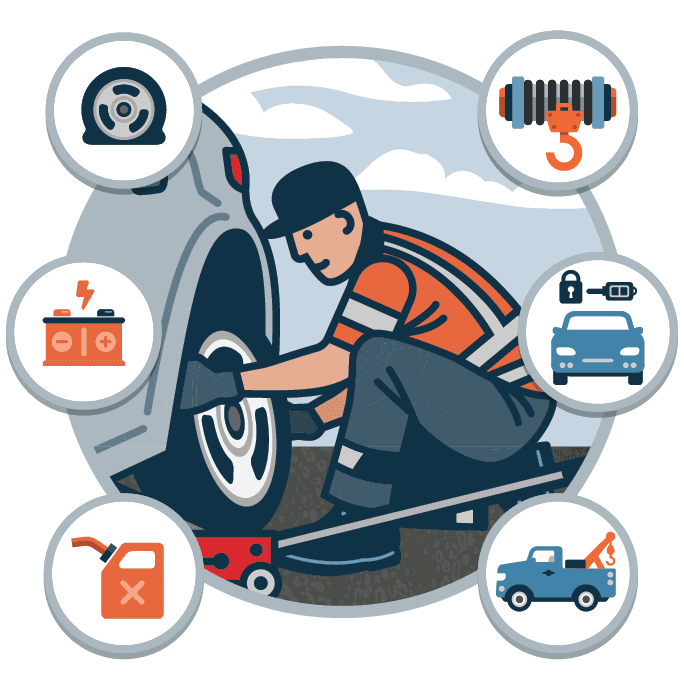2024 Guide to What To Do When Your Car or Truck Gets Stuck
Whether your vehicle is old, new, or somewhere in between, there's a chance that at some point, you'll find yourself stuck. In some cases, it will be easy to figure out the cause — and in others, it will be a mystery at least until roadside assistance pulls up with professional help.
When your car or truck gets stuck, Curbside SOS can be a lifeline, connecting you with nearby roadside assistance professionals from a network of more than 4,000 service providers nationwide. But even once you do reach out for expert assistance, there's a lot you can do before, during, and even after your car or truck gets stuck, to make the situation more manageable.
In this article:
- Common Reasons Cars Get Stuck
- First Steps to Take When Your Car Gets Stuck
- When to Attempt Self-Recovery vs. When to Call a Tow Service
- How Curbside SOS Can Help with a Stuck Vehicle
- Preparing for the Tow Truck's Arrival
Common Reasons Cars Get Stuck
Vehicles, be they cars or trucks, can find themselves stuck for a host of reasons. These can range from simple mechanical failures, like running out of gas, to getting caught in challenging weather or terrain conditions. Here are some common culprits:
Mud and Soft Ground.
After heavy rain, muddy conditions can trap vehicles, with wheels spinning helplessly as they lose traction.
Snow and Ice.
These slippery conditions can lead vehicles to slide off into snow banks or get stuck on icy patches.
Off-Roading Mishaps.
Getting adventurous—or a moment of inattention—can lead to veering into ditches or navigating tricky, uneven terrain.
Sandy Situations.
Beaches and deserts have their own unique challenges, with vehicles often sinking into soft sand.
No matter the cause, the outcome is the same: Your vehicle is stuck, and moving it seems like a Herculean task.
First Steps to Take When Your Car Gets Stuck
When you realize your car is indeed stuck (and yes, it happens to the best of us), it's important to act quickly but calmly to ensure everyone's safety.
Assess Your Surroundings.
First things first, stay cool-headed and check for any immediate dangers around you and your passengers.
Try to Free the Vehicle.
If it seems safe to do so, you might attempt to get your car moving again. Techniques like rocking the vehicle gently back and forth or using traction aids under the wheels can sometimes do the trick.
Signal for Help.
Make sure other drivers can see you're in trouble. Turn on your hazard lights and, if you've got them, set out flares for extra visibility. Your smartphone is your ally here — use it for navigation, communication, and to call for assistance if needed.
When to Attempt Self-Recovery vs. When to Call a Tow Service
Deciding whether to try and free your vehicle yourself or to call in a tow service can depend on a few factors. If you're equipped with emergency tools like traction mats, shovels, or winches, and you're confident in how to use them, giving self-recovery a shot might be a good idea.
However, there are several reasons why you might choose not to go this route. The current road and weather conditions play a big part — they can make self-recovery efforts more difficult or even dangerous. The safety and comfort of you and your passengers are crucial too. If you're without the necessary equipment or the know-how to use it, or if there's a risk of damaging your vehicle in the attempt, it's probably safer and wiser to call for a tow service.
In short, weigh the situation carefully. If self-recovery poses any risk or if you're unsure about your ability to safely execute it, it's always better to err on the side of caution and call for professional help.
How Curbside SOS Can Help with a Stuck Vehicle
Curbside SOS is designed to be your go-to solution when your vehicle gets stuck. They offer a quick and easy way to connect with nearby roadside assistance professionals who are well-equipped to handle various situations. When reaching out to Curbside SOS, it's crucial to give a clear picture of your predicament. Provide them with your exact location, describe the condition of your vehicle, and detail the terrain you're stuck in. This information is key in helping the towing company prepare the right equipment and plan the best approach for your rescue, ensuring a quicker and more effective solution.
Preparing for the Tow Truck's Arrival
While waiting for the tow truck to arrive, take a moment to gather any necessary items from your vehicle, like your ID, insurance information, and personal belongings. Preparing these in advance will ensure you're ready to go once the tow truck arrives. For your safety, remain in a secure location, well away from traffic and hazards. This is particularly important if you're stuck in bad weather or a potentially risky area.
Vehicles getting stuck is a common occurrence, but being armed with the right knowledge beforehand and calling in the right help when it happens can make a big difference. By following these steps, you can ensure your safety and that of your passengers, while also minimizing any potential damage to your vehicle. The road might throw unexpected challenges your way, but with a well-thought-out response plan, you can handle these situations smoothly and safely.
